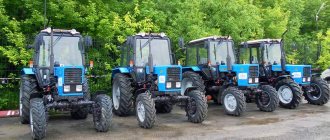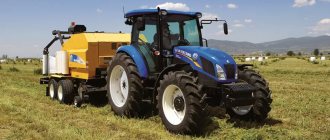08/30/2018 No views
As statistics show, the Russian forklift market is dominated by models with internal combustion engines, which are significantly larger than their counterparts that run on electricity. This equipment is operated in harsh conditions that require large resources. That is why one of the most important parameters to pay attention to is the fuel consumption of the forklift.
The cost of goods and work performed is directly calculated based on the fuel and lubricants used. The problem is that the fuel consumption of front loaders is much more difficult to determine than for a conventional vehicle, because for this equipment there is no defined standard for a range of 100 km.
Key Features
Fuel consumption, which in most cases is indicated by manufacturers, is as follows: number of grams / unit of power. That is why there is a rather strong discrepancy in the numbers, which creates even more confusion not only for the average person, but also for experienced drivers.
The fuel consumption indicated by the company that manufactures the equipment does not give any understanding of how much a particular engine will actually consume. It is not clear what the norm will be for an hour, a work shift or a whole month of operation. In this case, it is impossible to do without the use of certain theoretical knowledge and calculations.
How much fuel does a diesel forklift consume?
Calculation of fuel consumption rates per hour, shift, month, etc.
O. Shevtsova
It is estimated that in the Russian market of counterbalanced forklifts the ratio of equipment with an internal combustion engine and an electric drive is 68%:32%. The predominance of forklifts is explained by the fact that industrialization processes (industrial and construction development) in our country are still a greater incentive for the loading equipment market than the development of warehouse logistics. That is, currently the main consumers of forklifts in Russia are enterprises and companies from various industries, and not logistics, although the latter is developing at a fairly rapid pace.
The operating features of the equipment also play a certain role: operation for a significant part of the year at low temperatures in open areas, coatings that are far from ideal, etc. A diesel engine requires lower costs for purchase, maintenance, and operation - it is a reliable, easy to maintain, powerful and efficient source of energy.
In addition, such machines are produced in a wide range of carrying capacity (up to 43 tons) and with a wide range of attachments for performing various technological operations, and the exhaust gas purification system (particulate filters), used in the latest models of leading manufacturers, reduces harmful emissions by 70...
98%, which allows you to work indoors.
One of the characteristics of the “price of ownership” of a diesel forklift is fuel consumption. In the summary table of technical characteristics, the manufacturer often indicates specific fuel consumption in grams per unit of power measurement (hp or kW). Meanwhile, this parameter does not give an idea of how much a given engine will “eat” in practice, how much fuel will be consumed per hour, shift, per month, etc. For this, special techniques are used, one of which we will introduce readers.
How to calculate fuel consumption rate
Let's say a loader has already been purchased and put on the balance sheet of the enterprise. The accounting department asks the employees of the official dealer's service center for estimated data for fuel write-off.
How to calculate fuel consumption rate
The fuel consumption rate for forklifts is determined by the following formula:
Q = (N*q)/(1000*R*k), where
N is an indicator of the power of specific diesel engines, which is installed in a specific model for which the calculation is being carried out.
q is the nominal fuel consumption, which is specified in the relevant documentation for the engine.
R is an indicator of the density of the diesel fuel used. This parameter is known initially, according to the approved standard (840 kg/m3 for winter and 860 kg/m3 for summer). For convenience, the general indicator is set at 0.85 kg/dm3.
k is a certain coefficient that reflects the time period in percentage terms when the front loader was operated in normal mode and the amount of time when it was used at maximum crankshaft speed.
Gbiru 02/13/2018… Specific examples
| Fuel consumption calculator - gasoline consumption calculator, widgets for the site. Knowing how the hour meter on a tractor works, it is not difficult to do this accurately, based on the actual wear of the crankshaft, piston system and other components of the power plant. A convenient search form by name and article number, as well as the ability to order missing parts directly from the manufacturer, allow us to satisfy the needs of a wide range of customers. |
- N is the engine power, measured in kW;
- t – fuel consumption time, that is, 1 hour;
- G – specific fuel consumption of the vehicle, g/kWh;
- % – percentage of machine load during operation;
- p – fuel density. For diesel, the density is constant and is 850 grams per liter.
The procedure for accounting and writing off fuel and lubricants according to waybills in 2017-2018 • Manufacturers, on the contrary, set the consumption per unit of engine power.
Practical nuances
From the above information we see that almost all parameters when determining the fuel consumption of a forklift are known in advance, which cannot be said about the last coefficient (k).
To understand the situation, consider two examples:
- The equipment works at the railway station, loading and unloading railway cars. The shift is about 8 hours without a break. Workers are located on a platform that is located higher than the level of the special equipment, so the front loader forks do not rise to the height of the maximum boom reach. Maximum rotation of the engine crankshaft occurs only when the operator presses the pedal all the way, covering the distance between two certain points.
- The warehouse is open 24 hours a day. During the entire working day, there are two arrivals of trucks, which are unloaded in a few hours using the available equipment. It is at these moments that peak engine loads occur, but the rest of the time the crankshaft speed decreases, because the units perform warehouse work inside the warehouse without excessive intensity.
If we compare these two situations, then in the first case, the coefficient will be higher. This parameter takes into account peak loads - acceleration, downhill movement and lifting, during which the greatest use of equipment resources occurs. The calculation of fuel consumption for a front loader is determined based on the duration of its operation at peak crankshaft speeds from the total operating time (shift).
Calculation example
Let's assume that the company has a diesel forklift. It works a full shift (8 hours), without overcoming slopes and without using the maximum fork lifting height, since the sites it serves are located at a height of 1.5 - 2 meters. The maximum speed is only used when the machine is accelerating to cover the distance between the loading and unloading areas. This operation takes approximately 30% of working time.
The exact value of k1 can be determined by measuring the time during which the loader accelerates, overcomes inclines and lifts loads of maximum weight. Summing up the indicators, we obtain the operating time during which maximum loads are applied to the unit. And it is this time that needs to be subtracted from the duration of the shift.
The required coefficient is the ratio of operating time with minimum and maximum load (70% and 30%, respectively). Therefore, if the forklift was used at maximum load 30% of the time, the value of the coefficient is found by dividing 70% by 30% (that is, the value is 2.3).
For example, the loader is equipped with an engine with a power of 33.8 liters. With. In the event that 30% of the entire work shift is operated at maximum speed, then the fuel consumption for 1 engine hour will be: 33.8x202/(1000x0.85x2.3) = 3.49 liters.
Fuel consumption is, of course, affected not only by the duration of operation at maximum speed, but also by engine power and specific fuel consumption.
Equipment that has not been run-in, as well as loaders with high mileage, demonstrate higher fuel consumption. Excessive consumption can also be detected during special testing in the case of operation at maximum load. For example, a loader may show a consumption of 5 to 6 liters per hour, although the average value of this indicator is 3 liters per hour.
It should also be noted that in real conditions the engine is subject to less load than during test tests. To determine fuel consumption for write-off, you need to carry out a series of control measurements.
As an example, let's take the timing of the BX50 forklift from Komatsu (engine - FD30T-16, load capacity - 3,000 kilograms). Type of work operations - unloading trucks, as well as placing cargo in cars. The work is performed for 9 hours every day. Fuel consumption is 2.5 liters per hour of operation.
With the 4D92E power unit, with a shift duration of 24 hours, the fuel consumption of the equipment is:
- for loaders with a lifting capacity from 1,500 to 1,800 kilograms - 1.7 liters per hour;
- for loaders with a lifting capacity from 2,000 to 2,500 kilograms - 2.5 liters per hour.
With an eight-hour shift, the consumption of a loader with a lifting capacity of 1,500 kilograms is 2.2 liters, and with a lifting capacity of 1,800 kilograms - up to 2.95 liters per hour.
Gasoline forklift engine What are engine hours
| How to calculate fuel consumption for a loader - formula and calculations Another important nuance is the fact that a recently purchased unit that has not yet been properly run-in, as well as one that has a decent mileage, are all characterized by increased fuel consumption. A wide variety of warehouse equipment makes it possible to flexibly optimize the production process of almost any warehouse, taking into account all the characteristics of the cargo and the costs of unloading and loading it. |
How to extend service life and reduce consumption
Diesel forklifts are considered reliable machines that operate not only in closed warehouses, but also in open areas, even in difficult climatic conditions. To extend the service life and prevent an increase in diesel fuel consumption in advance, it is necessary to follow the manufacturer’s advice on loading and maintenance of machines.
- Change fuel filters and working fluids on time.
- Monitor temperature limits.
- Use high quality diesel fuel, since foreign impurities are the cause of failure of diesel equipment.
- Monitor the quality of the atomizer, as defects in this unit lead to burnout of the piston.
Excessive consumption of diesel fuel is not only an economic problem for an enterprise, but also a signal that equipment needs immediate diagnostics and prevention.
Engine hour concept
Special equipment is equipped with an engine hour sensor - a device that helps keep under control the duration and efficiency of full engine operation. Its operation is simple: as soon as the motor is turned on, a counter (electrical or mechanical) is started, which begins to record information about the frequency of rotation of the shaft, using an indicator specially designed for this purpose. On electric equipment, the sensor turns on when the operator is sitting on the seat (the limit switch is closed), on diesel equipment - when the engine is running
Using such a device, you can find out the duration of operation of equipment for any time period. Therefore, it is important to understand that 1 engine hour is not equal to one hour of actual operating time.
Features of maintenance of electric forklifts
When servicing electric forklifts, almost all the same rules are followed as when servicing gasoline equipment.
The difference is that they do not need to change the oil in the engine and gearbox, since electrical equipment does not have these components. The optimal maintenance frequency is considered to be 1000 operating hours. In addition, a time period of 12 months is also established.
Batteries require special attention. Especially traction batteries, which need to be periodically charged and maintained. It is worth making sure that the charge level never drops below 30%. Another point is that it is necessary to monitor the electrolyte level, since a lot of liquid evaporates during the operation of the battery. If you do not add distilled water in a timely manner, the battery will quickly fail.
Timely maintenance of a forklift can guarantee the reliability and safety of its use, and is also guaranteed to extend its service life.
Q = Nq/(1000Rk1), where:
Fuel consumption standards for a forklift are one of the main issues that any owner of this equipment faces. Sometimes the manufacturer indicates fuel consumption per unit of power (horsepower or kilowatts) in grams. This information can be found in the forklift specifications table, but it does not always give a clear picture of actual consumption.
The rate of fuel consumption per engine hour is calculated using the formula:
N — engine power (in hp);
q is the indicator of specific fuel consumption of the loader;
R is the density of the fuel (diesel). Usually taken at the level of 0.85 kg/dm3;
k1 is the percentage ratio of the operating time at maximum crankshaft speed.
Engine power and specific fuel consumption can be found in the maintenance instructions. The data is included in it in the form of a graph. The schedule is created by specialists from the manufacturing plant. The basis for this is the results of tests in different modes. In practice, the maximum engine speed can be achieved by pressing the accelerator pedal all the way. Of course, in this mode the loader will only work for part of the shift. Therefore, it is necessary to use a coefficient designated as k1. This coefficient characterizes what part of the work shift the loader operates at maximum loads. It can be called an individual indicator of the specific operation of the loader.
Specifications
| (A) Working height: | 3862 mm |
| (B) Height with operator's cab: | 1938 mm |
| (C) Rear overhang angle: | 23° |
| (D) Ground clearance: | 191 mm |
| (E) Wheelbase: | 1030 mm |
| (F) Length without attachment: | 2588 mm |
| (G) Length with standard bucket: | 3309 mm |
| (H) Ground Rollback: | 25° |
| (I) Dump height with standard bucket: | 2310 mm |
| (J) Height to bucket pin: | 3002 mm |
| (K) Dump radius at maximum height: | 753 mm |
| (L) Dump angle at maximum height: | 42° |
| (M) Rollback at max. boom lift height: | 95° |
| (N) Bucket Width, 68 inches: | 1727 mm |
| (O) Turning radius with standard bucket: | 2001 mm |
| (P) Track, tires 10-16.5 - 10-ply: | 1385 mm |
| (Q) Tire width, 10-16.5, 10-ply: | 1676 mm |
| Loader performance | |
| Bucket lifting force: | 1601 dN |
| Bucket tilt force: | 1579 dN |
| Rated load capacity: | 895 kg |
| Tipping load: | 1872 kg |
| Axial torque: | 5423 Nm |
| Function execution time | |
| Boom lift: | 3.50 s |
| Boom lowering: | 2.50 s |
| Returning the bucket to its original position: | 1.90 s |
| Bucket tipping: | 2.40 s |
| Mass characteristics | |
| Operating weight (S175): | 2853 kg |
| Operating weight (S175H): | 2873 kg |
| Shipping weight: | 2488 kg |
| Engine | |
| Brand, model: | Kubota/V2203-M-DI-E2B-BC-3 |
| Fuel type: | Diesel |
| Cooling system: | Liquid |
| Power at 2800 rpm: | 34.3 kW |
| Rated speed (according to EEC 80/1269 and ISO 9249): | 2800 rpm |
| Torque at 1700 rpm (according to SAE JI 995 Gross): | 145 Nm |
| Number of cylinders: | 4 |
| Cylinder displacement: | 2196 cm3 |
| Cylinder diameter: | 87 mm |
| Piston stroke: | 92 mm |
| Lubrication: | Gear pump pressure |
| Crankcase ventilation: | Closed system |
| Air filter: | Dry replaceable cartridge with safety element |
| Ignition: | Diesel Compression |
| Launcher: | Glow plugs |
| Electrical equipment | |
| Generator: | Belt Drive - 90 A - Open |
| Accumulator battery: | 12 V - 600 A when cranking a cold engine at -18 ° C - reserve capacity 115 min |
| Starter: | 12 V - gear reducer - 2.7 kW |
| Hydraulic system | |
| Pump type: | Drive by motor, gear type. |
| Pump performance at 3135 rpm – S175: | 64 l/min |
| Pump performance at 3135 rpm – S175H: | 100 l/min |
| Relieving pressure in the system for quick release couplings: | 22.4-23.1 MPa |
| Hydraulic distributor: | Three-spool open-center type with float stop when rising and electrically controlled auxiliary. |
| Hydraulic filter | Full-flow replaceable - an element made of synthetic material with a porosity of 3 microns. |
| Hydraulic lines: | Pipelines, hoses and fittings according to SAE standard. |
| Hydraulic cylinders | |
| Boom lift cylinder (2 pcs): | Double action |
| Boom lift cylinder diameter: | 63.5 mm |
| Boom lift cylinder rod: | 38.1 mm |
| Boom lift cylinder stroke: | 601 mm |
| Bucket tilt cylinder (2 pcs): | Double-acting with suspension function when emptying the bucket and returning the bucket to its original position. |
| Bucket Tilt Cylinder Diameter: | 69.8 mm |
| Bucket tilt cylinder rod: | 34.9 mm |
| Bucket tilt cylinder stroke: | 335.0 mm |
| Drive system | |
| Transmission: | Infinitely variable hydrostatic piston twin pumps driving two fully reversible hydrostatic motors. |
| Final Drive Chains: | Pre-tensioned #80 HSOC endless roller chain (no trailing link) with oil lubricated sprockets in a sealed chain case. (Chains do not require periodic adjustment). Two chains on each side, without intermediate sprocket. |
| Main drive: | Fully hydrostatic, 4-wheel drive. |
| Axle size: | 50.8 mm, heat treated. The axle stockings are welded to the chain drive housing. Labyrinth axle seal. |
| Wheel bolts: | Eight 9/16-inch wheel bolts that attach to the axle hubs. |
| Drive traction | |
| Standard tires: | 10 x 16.5 - 10 Ply - Heavy Duty Bobcat. |
| For heavy duty offset applications: | 10 x 16.5 - 10-ply, heavy-duty Bobcat with offset rim. |
| Ultra-wide all-terrain tires: | 31 x 12-16.5 - 10-Ply - Bobcat Heavy Duty Fleet. |
| Heavy Duty Tires: | 10 x 16.5 - 10-ply, Bobcat heavy duty. |
| Foam tires: | 10 x 16.5 - 10-ply, heavy-duty Bobcat with foam core. |
| Movement speed: | 11.8 km/h |
| Refill tanks | |
| Chain housing reservoir capacity: | 30.3 l |
| Cooling system capacity with heater: | 11.3 l |
| Cooling system capacity without heater: | 10.2 l |
| Engine lubrication system capacity (with filter): | 8.7 l |
| Fuel tank capacity: | 90.8 l |
| Hydraulic reservoir capacity: | 18.2 l |
| Hydraulic/hydrostatic system capacity: | 34.1 l |
The importance of forklift maintenance and its frequency
There is a misconception that if the forklift is just sitting there and no one is using it, then maintenance is not needed. However, the opposite is true: when moving, components and mechanisms are lubricated, so equipment standing idle can become unusable much faster.
Forklift maintenance is also necessary when the safety margin of a particular joint comes to an end. Based on the service life of the elements, engine hour readings and the age of the forklift, the frequency of scheduled maintenance is calculated.










